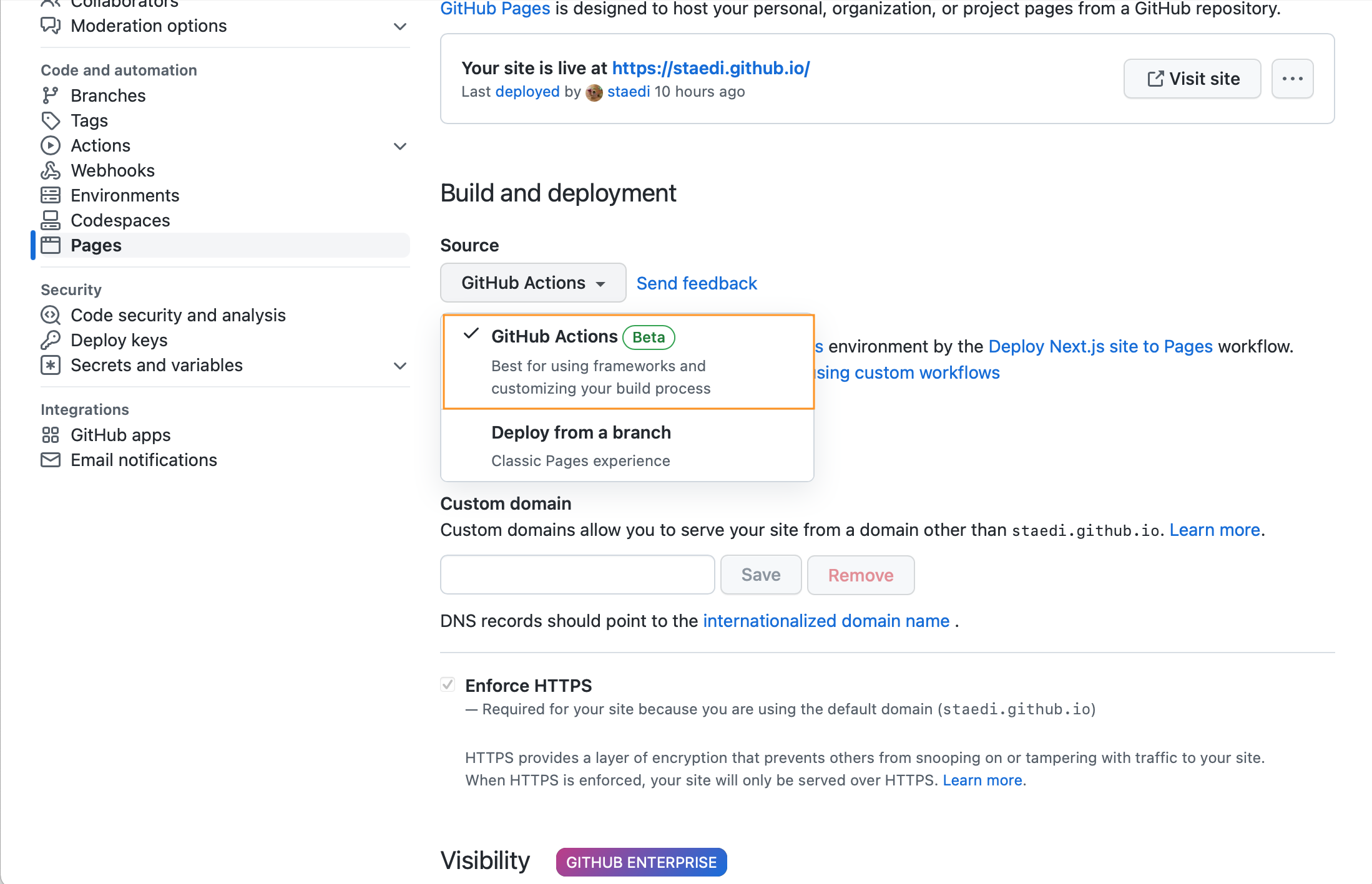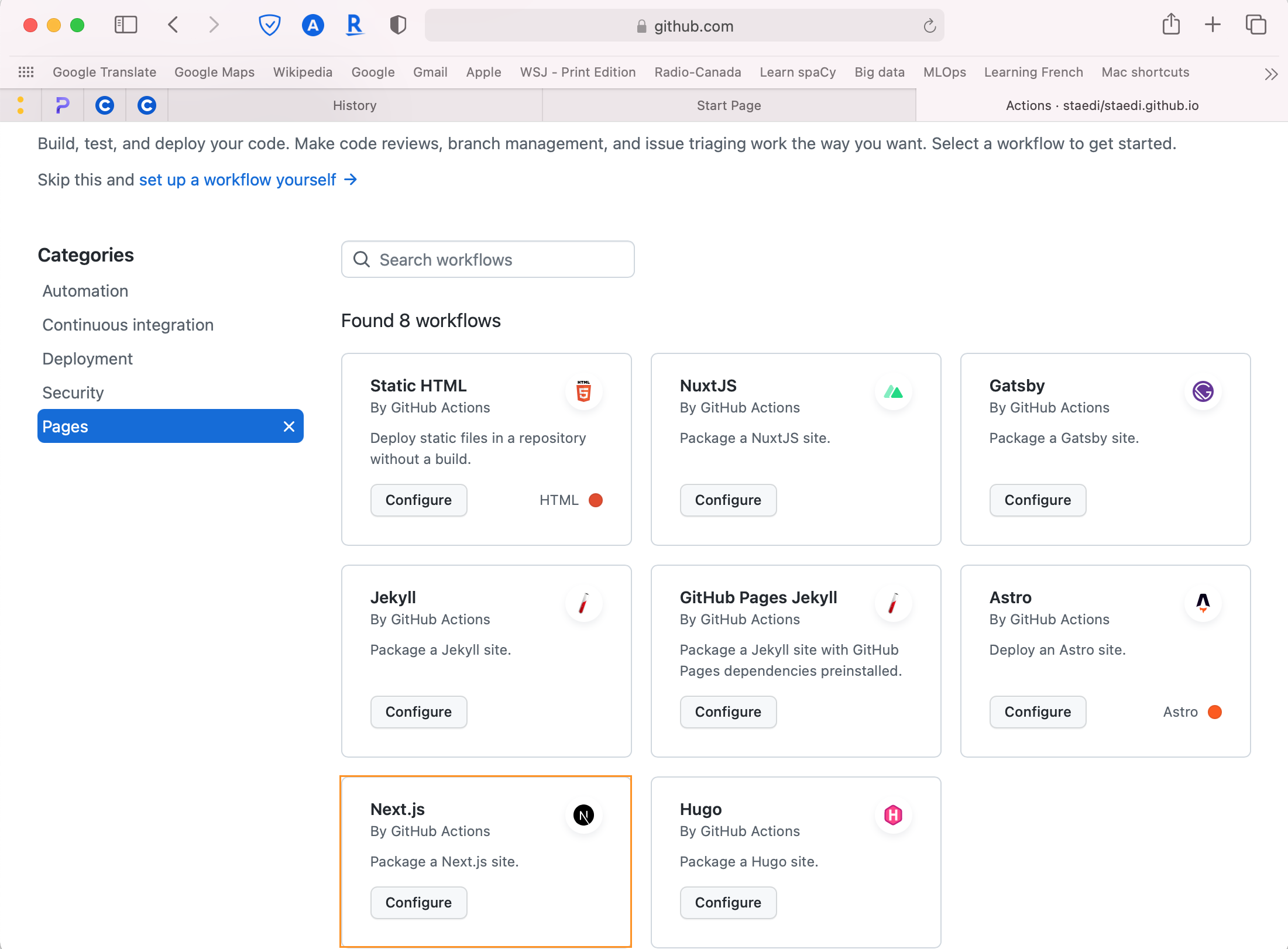Deploying GitHub Action for Next.js application
Next.js
As many well know, Next.js is one of the most popular and is gaining popularity frameworks amongst developers (mostly frontend).
In a sentence, Next.js can be thought of a toolkit (framework) for easier React.js (library) development.
Another important to mention is that the notable functionality of Next.js is the server-side rendering.
With this, Next.js can learn faster than client-side rendering (vanilla React.js or Gatsby.js) while deploying on the web for static site might be a little bit tricky.
Why Next.js
Its versatile functions aside, my intention to try it out was fairely simple. I was intrigued by available Next.js templates just like the one you're reading even though I only had a stint of React.js experience.
This contrasts to other frameworks or tools compatible with GitHub Pages.
Take its main rival Gatsby.js for an example. Obviously, many templates are available but the overall quality (at least visually) of them didn't satisfy me.
While I made a small modifications with this template, it was minimal as to tweak the layout to display available tag lists above articles.
Using Next.js in GitHub
While using Next.js in GitHub shouldn't be a problem with the flexible GitHub Pages, Next.js recommemends Vercel (opens in a new tab) (who develops Next.js) to deploy the Next.js applications.
In fact, many Next.js applications I came across on GitHub have been deployed on Vercel.
As I prefer sticking on GitHub (somehow I like the .github.io domain), I am against using other than GitHub Pages.
How?
Next.js setting
As mentioned in the beginning, Next.js can render page on the server and that is the culprit which complicates the problem of deployment on GitHub Pages.
Namely, Next.js's image optimization functionality is done on the side-side and to deploy on GitHub Pages, it should be disabled inside the module.exports setting.
const withNextra = require('nextra')({
theme: './theme.tsx',
staticImage: true,
defaultShowCopyCode: true,
readingTime: true,
// optional: add `unstable_staticImage: true` to enable Nextra's auto image import
})
/** @type {import('next').NextConfig} */
const nextConfig = {
// any configs you need
}
module.exports = {
...withNextra(nextConfig),
images: {
unoptimized: true,
}
};Notice the unoptimized: true setting inside the images of module.exports setting.
Pages Setting
While not entirely mandatory, it might be helpful to choose the Build and deployment Source from which the workflow is run.
That is because with the default Deploy from a branch setting, new push to the repository would trigger GitHub Pages's default Jekyll workflow in addition to Next.js workflow.
When I switched to GitHub Actions option, only one workflow (Next.js) runs.

Which Action to choose
On the web, many instructions available for Next.js start with Node.js workflow rather than one specific to Next.js.
Since Next.js workflow is available on the platform, it might be easier place to start.

Disabling Jekyll
Whatever type of application you deploy, GitHub Pages tries to build Jekyll. To avoid this, add .nojekyll file inside ./out directory as part of the workflow. ./out directory is where static pages reside for GitHub Pages.
pnpm setup
The original Next.js workflow cannot deal with pnpm therefore to use it, pnpm setup should be manually done.
Disabling cache
While I'm not sure if it happens everytime, in my case, with the caching option enabled, freshly deployed GitHub Pages didn't show all the article lists although I could access each one my directly entering the address.
As I commented caching in the script, it worked!
Complete workflow script
# Sample workflow for building and deploying a Next.js site to GitHub Pages
#
# To get started with Next.js see: https://nextjs.org/docs/getting-started
#
name: Deploy Next.js site to Pages
on:
# Runs on pushes targeting the default branch
push:
branches: ["main"]
# Allows you to run this workflow manually from the Actions tab
workflow_dispatch:
# Sets permissions of the GITHUB_TOKEN to allow deployment to GitHub Pages
permissions:
contents: read
pages: write
id-token: write
# Allow one concurrent deployment
concurrency:
group: "pages"
cancel-in-progress: true
jobs:
# Build job
build:
runs-on: ubuntu-latest
steps:
- name: Checkout
uses: actions/checkout@v3
- name: Setup pnpm
uses: pnpm/action-setup@v2
with:
version: 7.28.0
- name: Detect package manager
id: detect-package-manager
run: |
if [ -f "${{ github.workspace }}/yarn.lock" ]; then
echo "manager=yarn" >> $GITHUB_OUTPUT
echo "command=install" >> $GITHUB_OUTPUT
echo "runner=yarn" >> $GITHUB_OUTPUT
exit 0
elif [ -f "${{ github.workspace }}/package-lock.json" ]; then
echo "manager=npm" >> $GITHUB_OUTPUT
echo "command=ci" >> $GITHUB_OUTPUT
echo "runner=npx --no-install" >> $GITHUB_OUTPUT
exit 0
elif [ -f "${{ github.workspace }}/pnpm-lock.yaml" ]; then
echo "manager=pnpm" >> $GITHUB_OUTPUT
echo "command=install --frozen-lockfile" >> $GITHUB_OUTPUT
echo "runner=pnpm" >> $GITHUB_OUTPUT
exit 0
else
echo "Unable to determine packager manager"
exit 1
fi
- name: Setup Node
uses: actions/setup-node@v3
with:
node-version: "18"
cache: ${{ steps.detect-package-manager.outputs.manager }}
- name: Setup Pages
uses: actions/configure-pages@v3
with:
# Automatically inject basePath in your Next.js configuration file and disable
# server side image optimization (https://nextjs.org/docs/api-reference/next/image#unoptimized).
#
# You may remove this line if you want to manage the configuration yourself.
static_site_generator: next
# - name: Restore cache
# uses: actions/cache@v3
# with:
# path: |
# .next/cache
# # Generate a new cache whenever packages or source files change.
# key: ${{ runner.os }}-nextjs-${{ hashFiles('**/package-lock.json', '**/yarn.lock') }}-${{ hashFiles('**.[jt]s', '**.[jt]sx') }}
# # If source files changed but packages didn't, rebuild from a prior cache.
# restore-keys: |
# ${{ runner.os }}-nextjs-${{ hashFiles('**/package-lock.json', '**/yarn.lock') }}-
- name: Install dependencies
run: ${{ steps.detect-package-manager.outputs.manager }} ${{ steps.detect-package-manager.outputs.command }}
- name: Build with Next.js
run: ${{ steps.detect-package-manager.outputs.runner }} next build
- name: Static HTML export with Next.js
run: ${{ steps.detect-package-manager.outputs.runner }} next export
- name: Add .nojekyll file
run: touch ./out/.nojekyll
- name: Upload artifact
uses: actions/upload-pages-artifact@v1
with:
path: ./out
# Deployment job
deploy:
environment:
name: github-pages
url: ${{ steps.deployment.outputs.page_url }}
runs-on: ubuntu-latest
needs: build
steps:
- name: Deploy to GitHub Pages
id: deployment
uses: actions/deploy-pages@v1